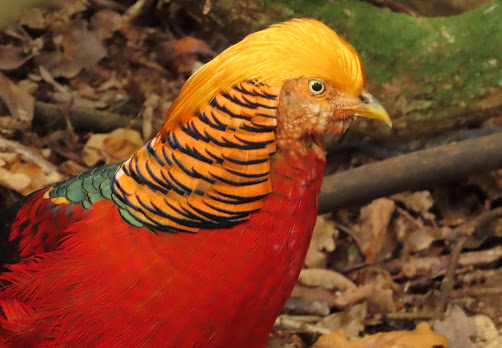GOLDEN PHEASANT on Tresco
There are certain areas of the country that are legendary for birdwacthing, places like the Suffolk and North Norfolk Coast, but there are few places that are so fabled as the Scillies, a mythical place to visit, especially in October. The roll call of rarities that pour into the islands makes anyone with an interest in birds salivate in the mouth. The Isles of Scilly just seems to attract the unusual more than anywhere else in the UK. So where better to spend a week's birding in October 2022 than those famous islands. And boy were they good.
Porth Loo Beach
The Isles of Scilly are situated off southern Cornwall, a two and a half hour boat journey from Penzance on the mainland, and being outlying islands attract the unusual birds. Rare birds turn up due to difficulties in their Autumn migration, strong winds blowing them off course or just getting lost, and so they end up on these islands somehow or other. Being so far off land, lying so far south and west, they attract birds not seen on the mainland, birds that might get lost at sea, often American. The Scillies are small and sparsely populated, a group of islands that huddle close to each other, the distance between them short. The islands are small, only a couple of miles long, so are easy to get around, walking roads and footpaths, the distance between things short. Places are not far from each other and in many cases areas where there are birds follow on to other ones, making it handy to do several twitches in one day, even making it easy to travel to other islands fairly rapidly for a mega twitch.
The dock at St Agnes
Being my first time and travelling myself, I decided to go through a tour company, Birdfinders, run by Vaughan and Svetlana. This was a new company for me, so I was a bit concerned, but I liked the style, things were laidback and fairly easy going. A lot of tour operators are rigid, you go out and do this and this without any change, but with Birdfinders anyone could leave and do whatever they want. There were around ten people joining me in the tour and for a change there were people of my age in the group, not so many of the grey brigade, some coming back to the island, others like me arriving for the first time. It made for a good atmosphere, something different from my more usual, lonely birding, so unusual to share this strange past time with other people. It was also good to get some expert knowledge of the islands, Vaughan and Svetlana were well known birders there, to actually know where the places were and more importantly where to find the birds.
Hugh Town
It took me a couple of days to get to and from the islands, its a hard place to get to, especially with train strikes, believe me. I stayed there for a week from the 8/10 to 15/10, staying in Hugh Town on St Mary's, going to the islands of Tresco twice and St Agnes and Bryher once. St Mary's is the main island, more populated and cultivated, with mainly small grassy fields bordered by hedgerows, the other islands are rougher and wilder, less kept by man. Hugh Town is the largest settlement, where the ferry alights, a small settlement that winds around a circular bay. Its a delightful place, small, with maybe a thousands people, but is handy, with a bank, a post office, a coop, several pubs and some tourist shops. I stayed in a guest house called the Mincarlo, which had absolutely amazing views across the boat strewn bay to the other side of the town, which in the brilliant light reminded me of something more exotic. The islands feel like something different to what you usually expect of the UK, they are almost like a different country in some respects, yet at the same time there is a comfortable familiarity of being around British people.
What happens to unguarded cakes in the Scillies
Visiting the islands in October the mainly marine environment meant that the weather was often a mixed bag, changing daily, often hourly, something you could never predict. When I first landed on the islands it was like a summer's day, it felt like beach weather, and it felt so glorious to have finally set foot on such hallowed birdwatching grounds. For the rest of the trip the weather stayed fairly mellow, but on Tresco I once got caught out in a heavy rain storm, and got completely drenched, deciding it was a good idea to go out on an exposed walk on the north of the island, one of those soakings where everything got wet (my poor phone gave up the ghost after that). At the end of the stay waiting for the return ferry, some people told me that it stays so warm right into December, a place so unlike the rest of the UK, a completely unique place. I'm sad to leave it behind.
This post was a brief introduction to the Islands, if you would like a more detailed description, please read further posts. Its going to take a long time to write this blog, but its a labour of love and I will enjoy every moment, reliving the time I was out in the Scillies.








No comments:
Post a Comment